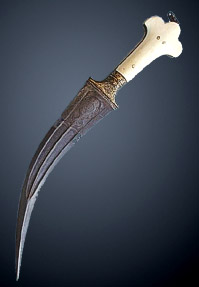|
|
|||
|
In the history of Indian arms and armours, we find a great variety of daggers. Most of them were created and used as combat weapons, others were designed as items of personal adornment, and yet others were products of fantasy.
(Indian soldiers on the march)
In general, the dagger has been an auxiliary weapon for soldiers. It was especially used in close combat. Moreover, this weapon was part of the formal attire of officials, courtiers and other civilians. The dagger, with its short blade, has always been a thrusting or a stabbing weapon. In this it differed from the long bladed sword, which could be used not only as a thrusting weapon but also as a cutting and slashing weapon. Hereafter, we will focus on four of the most important types of Indian daggers.
(Models of Katar, Jambia, Khanjar and Pesh Kabz daggers)
The most fascinating and effective dagger is the so-called Katar or Jamdhar. Its origins are to be found in Rajput, but the use of this particular type of weapon was widespread in all India. The hilt of the katar consists of two parallel arms extending backwards from the blade. These arms are connected by two or more cross-pieces which form the grip. The blade - always doubled-edged - is triangular in shape and usually thickens at the point.
(Katar with floral ornaments)
When held in the hand, the dagger is usually at a right angle to the arm and the force of the forearm drives it home. However, the katar is held by the cross grip and the blade is in line with the forearm (rather than at a 90 degree angle to it). When it is thrust forward like a straight punch, it therefore has not only the force of the arm behind it but also the weight of the body. This makes it a redoubtable weapon. Thrust in the above described manner, the blade can split open chain mail. We can thus explain the purpose of thickening the point of the dagger: in order to pierce and break the mail rings it has to be particularly strong. There are several variants of the katar. Some have ornamented hand guards, others have double blades, while still others have a central blade with opening pivoted arms on each side. Katar blades are straight as a rule, but occasionally one can find curved blades of this type.
The origin of so-called Jambias is Arabic. But these daggers are very popular all over western Asia and India. Their distinguished feature is a curved blade, typically double-edged and frequently ribbed. Hilts are their easiest identifiable features. They are ranging from fan shaped pommels to the smaller, flat-topped Indo-Persian style. The general shape of the hilt and the blade remains the same in different regions and different countries, however, the sheath of such daggers can differ considerably.
Somewhat similar to the jambias are the Khanjars, which usually have a curved blade and a hilt reminiscent of a pistol butt. Though khanjar daggers probably originated in Turkey, they became extremely popular in India. Over time they became more elaborately decorated than any other type of Indian dagger. Traditionally, the hilts are made of ivory, jade, crystal; frequently they are decorated with precious and semi-precious stones. In order to match the hilts, the sheaths are also richly ornamented.
Straight bladed daggers such as the Pesh Kabz are Persian in origin. They have tapering blades, which are ground back under the grip to form a distinct step. Another distinguishing feature is the broad T-rib along the back edge of the blade. Their grips are of made of different layers of bone, horn or ivory riveted to an extension of the blade. The point of the pesh kabz is very strong, like the katar it can thus be used to pierce the rings of coats of mail.
(Left: Pesh Kabz; Right: Khanjar)
|
|||
|
|
|||



